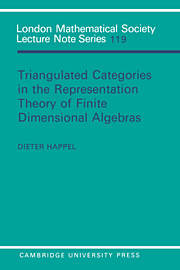CHAPTER III - Tilting theory
Published online by Cambridge University Press: 28 January 2010
Summary
In this chapter we try to give a rather full account of the tilting theory which emerged in recent years. The history of tilting is quite interesting and we take this opportunity to collect some of the important steps. The first approach to tilting appeared in the proof of Gabriel's theorem given by Bernstein, Gel'fand and Ponomarev (1973). In this article the so-called Coxeter functors were introduced. The usage was still quite restricted as it only dealt with finite-dimensional hereditary k-algebras. A few years later this approach was generalized by Auslander, Pis zek and Reiten (1979). In this paper a rather special ‘tilting module’ was introduced which nowadays is called an APR-tilting module and still is a very useful tilting module as we will see in the later developments. The decisive step in the building up of this theory was the work of Brenner and Butler (1980). A completely different point of view was presented. This work contained the first axiomatic description of a tilting module and several fundamental results were presented. Their basic approach gives still the main direction in tilting theory. Later the conditions of Brenner and Butler were relaxed by Happel and Ringel (1982) and the present state of most of the theory was formulated. There are several papers dealing with simplifications of the proofs. (Bongartz (1981), Hoshino (1983)) or with special aspects of the theory (Hoshino (1982), Smaltø (1984) and Assem (1984)). A more general approach to tilting was presented by Miyashita (1985) by relaxing the defining conditions even more.
- Type
- Chapter
- Information
- Publisher: Cambridge University PressPrint publication year: 1988



